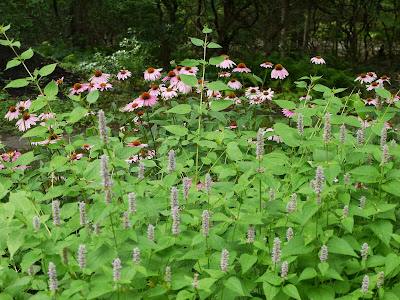 |
| All this rock was removed for one rhododendron |
Ever wonder why nothing is planted in the open hillside to the right of the main planting bed at Eklund? There's a reason for that! The hillside is where the house once stood. It had a walk-out basement and lower walls of fieldstone. After the fire, the city filled in the hole for safety reasons. The fill consisted of highly-compacted subsoil with loads of rocks, random chunks of concrete, asphalt, and metal. After a few decades, not even tree roots had tried growing it in.
 |
| All three new Rosebays ready for a rainy week. These will hopefully get quite large. |
To get things going and break up the monotony of the barren hillside, three Rosebay Rhododendrons were planted. Rosebays are native to Connecticut, but are uncommon. You see more of them in the woods as you head southwest a bit. This species can grow to be a giant, so if they thrive, that should really break up the hill. Perhaps some mountain laurel can be added in the future.
Each prepared hole was about six feet in diameter. After removing all the rocks, concrete, and bricks, several loads of rotting woodchips were mixed in. Some of the rocks were used to construct a terrace. It was a lot of work! Each shrub took 4-5 hours to plant. The last shrub was plant as the sky opened up for a week or so of predicted rain.
 |
| Foamflower |
 |
| Purple Coneflower transplanted a few days earlier |
 |
| Columbine |
 |
| Wild Strawberries |
Wild strawberries were planted many years ago and at first seemed to mostly die off. But over the years they popped up all over the place and even returned to spots where they had previously died off. Can't explain it!






























